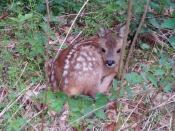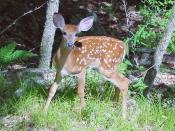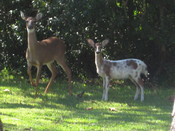The poem I chose is "Traveling Through the Dark" by William Safford. The first line of the poem sets the scene, as do most poems. The narrator has been confronted with a dilemma: Should he move the object out of is way (in this case, a deer on the side of the road)? He also indicates what course is usually taken, as this would be better for others. The deer he found at night time was dead. The dilemma is compounded by whether to roll it into a canyon, off the road. Doing so would require skill, because not only is it dark, but the road is narrow. If he swerves the car, there could be more deaths.
He used the car's tail light in the darkness to notie that the dead deer was a doe who had been recently killed. It was not too recently, because, although it was stiffened, it was not quite cold.
He dragged her away from the road, noticing her belly was large. Wondering why, he touched it, and noticed her side was warm. The reason was that there was a live fawn in the doe's belly, but he knew the fawn would not be born naturally. He hesitated beside that road, wondering what to do.
He stood to the rear of the car with the engine running, and he could her the silence in the wilderness, as though it were listening to what was taking place.
His thoughts were the moral dilema, as "he thought for all of us" (1241). He thought about would be the right thing to do, and his swerving was tring to decide the best course of action -- perhaps to try to get the fawn out of the doe's belly so it could live or to push the...


